Related Research Articles

The Agulhas Current is the western boundary current of the southwest Indian Ocean. It flows south along the east coast of Africa from 27°S to 40°S. It is narrow, swift and strong. It is suggested that it is the largest western boundary current in the world ocean, with an estimated net transport of 70 sverdrups, as western boundary currents at comparable latitudes transport less — Brazil Current, Gulf Stream, Kuroshio.
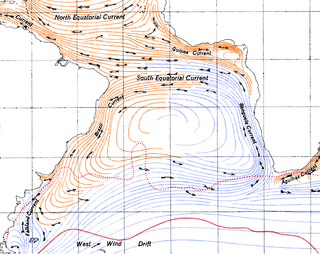
The Benguela Current is the broad, northward flowing ocean current that forms the eastern portion of the South Atlantic Ocean gyre. The current extends from roughly Cape Point in the south, to the position of the Angola-Benguela front in the north, at around 16°S. The current is driven by the prevailing south easterly trade winds. Inshore of the Benguela Current proper, the south easterly winds drive coastal upwelling, forming the Benguela Upwelling System. The cold, nutrient rich waters that upwell from around 200–300 m (656–984 ft) depth in turn fuel high rates of phytoplankton growth, and sustain the productive Benguela ecosystem.
The East Madagascar Current is an oceanic flow feature near Madagascar. It flows southward from 20°S on the east side of Madagascar to the southern limit at Cape Saint Marie and subsequently feeds the Agulhas Current. Its flow is complicated by large cyclonic and anticyclonic eddies.
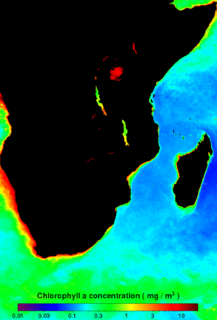
The sardine run of southern Africa occurs from May through July when billions of sardines – or more specifically the Southern African pilchard Sardinops sagax – spawn in the cool waters of the Agulhas Bank and move northward along the east coast of South Africa. Their sheer numbers create a feeding frenzy along the coastline. The run, containing millions of individual sardines, occurs when a current of cold water heads north from the Agulhas Bank up to Mozambique where it then leaves the coastline and goes further east into the Indian Ocean.
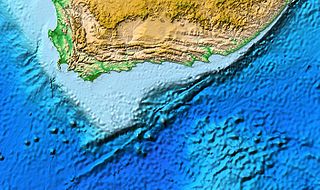
The Agulhas Bank is a broad, shallow part of the southern African continental shelf which extends up to 250 km (160 mi) south of Cape Agulhas before falling steeply to the abyssal plain.
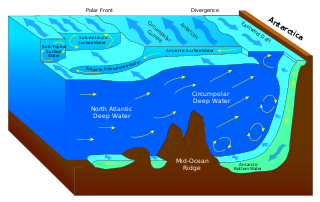
The Antarctic bottom water (AABW) is a type of water mass in the Southern Ocean surrounding Antarctica with temperatures ranging from −0.8 to 2 °C (35 °F) and salinities from 34.6 to 34.7 psu. As the densest water mass of the oceans, AABW is found to occupy the depth range below 4000 m of all ocean basins that have a connection to the Southern Ocean at that level.
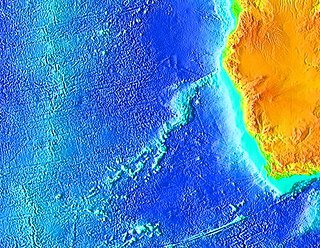
The Walvis Ridge is an aseismic ocean ridge in the southern Atlantic Ocean. More than 3,000 km (1,900 mi) in length, it extends from the Mid-Atlantic Ridge, near Tristan da Cunha and the Gough Islands, to the African coast. The Walvis Ridge is one of few examples of a hotspot seamount chain that links a flood basalt province to an active hotspot. It is also considered one of the most important hotspot tracks because the Tristan Hotspot is one of few primary or deep mantle hotspots.

Nils Daniel Bang was a South African oceanographic scientist who was a pioneer in the study of the fine structure of coastal upwelling systems. In March 1969, Bang initiated, planned and executed South Africa's first truly multi-ship oceanographical research operation, the Agulhas Current Project, along the current's length. Although the research was conducted on a limited budget and with rudimentary equipment, Bang's studies using thousands of closely spaced bathythermograph readings were later corroborated by satellite imagery and airborne radiation thermometry.
Retroflection is the movement of an ocean current that doubles back on itself.

Genypterus capensis, commonly known as kingklip, is a species of cusk eel occurring along the Southern African coast from Walvis Bay in Namibia to Algoa Bay in South Africa, and is closely related to Genypterus blacodes from New Zealand. The species grows to a maximum length of 180 cm, a weight of 15.0 kg, and is one of the most popular fish items on South African menus. Despite appearances, it is not closely related to the eel family of Anguilliformes.
Johann Reinder Erlers Lutjeharms, was a leading South African marine scientist and an authority in the oceanography of the Agulhas Current, who authored a definitive work on the subject, The Agulhas Current. His main field of investigation was the large-scale circulation patterns of the oceans adjacent to southern Africa and their influence on weather and climate, and he participated in 17 research cruises and was responsible for a further 48 projects undertaken on such cruises.

The Agulhas Return Current (ARC) is an ocean current in the South Indian Ocean. The ARC contributes to the water exchange between oceans by forming a link between the South Atlantic Current and the South Indian Ocean Current. It can reach velocities of up to 4 knots and is therefore popular among participants in trans-oceanic sailing races.

The marine ecoregions of the South African exclusive economic zone are a set of geographically delineated regions of similar ecological characteristics on a fairly broad scale, covering the exclusive economic zone along the South African coast.
The following index is provided as an overview of and topical guide to the protected areas of South Africa:
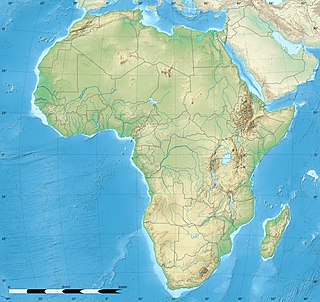
The Agulhas Bank Complex Marine Protected Area is an offshore marine protected area on the continental shelf lying approximately 39 nautical miles southeast of Cape Agulhas off the Western Cape in the Exclusive Economic Zone of South Africa.

The Agulhas Front Marine Protected Area is an offshore conservation region in the exclusive economic zone of South Africa

The Marine biodiversity of South Africa is the variety of living organisms that live in the seas off the coast of South Africa. It includes genetic, species and ecosystems biodiversity in a range of habitats spread over a range of ecologically varied regions, influenced by the geomorphology of the seabed and circulation of major and local water masses, which distribute both living organisms and nutrients in complex and time-variable patterns.

Temperate Southern Africa is a biogeographic region of the Earth's seas, comprising the temperate waters of southern Africa, where the Atlantic Ocean and Indian Ocean meet. It includes the coast of South Africa and Namibia, and reaches into southern Angola. It also includes the remote islands of Amsterdam and Saint-Paul, to the east in the southern Indian Ocean.
The Biodiversity of South Africa is the variety of living organisms within the boundaries of South Africa and its exclusive economic zone. South Africa is a region of high biodiversity in the terrestrial and marine realms. The country is ranked sixth out of the world's seventeen megadiverse countries, and is rated among the top 10 for plant species diversity and third for marine endemism.

The Angola - Benguela front (ABF) is a permanent frontal feature situated between 15° and 17°S off the coast of Angola and Namibia, west Africa. It separates the saline, warm and nutrient-poor sea water of the Angola Current from the cold and nutrient-rich sea water associated with the Benguela Current.
References
- ↑ Bang, N. D., and W. R. H. Andrews (1974), Direct current measurements of a shelf-edge frontal jet in the southern Benguela system, Journal of Marine Research , 32, 405 – 417
- ↑ South African Journal of Science (January 1978) Vol 74
- ↑ Gordon, Arnold L., Johann R. E. Lutjeharms and Marten L. Grondlingh (1987) Stratification and Circulation at the Agulhas Retroflection. Deep-Sea Research Vol 34, No 4, pp 570
- ↑ Shannon L.V. and M.J. O’Toole (1999) Synthesis And Assessment of Information on the Benguela Current Large Marine Ecosystem (BCLME). Thematic Report No 2. Integrated Overview of the Oceanography and Environmental Variability of the Benguela Current Region. Windhoek, Namibia
- ↑ Lutjeharms J.R.E., J.V. Durgadoo and I.J. Ansorge (2007) Surface drift at the western edge of the Agulhas Bank. South African Journal of Science, 103, 63 – 68